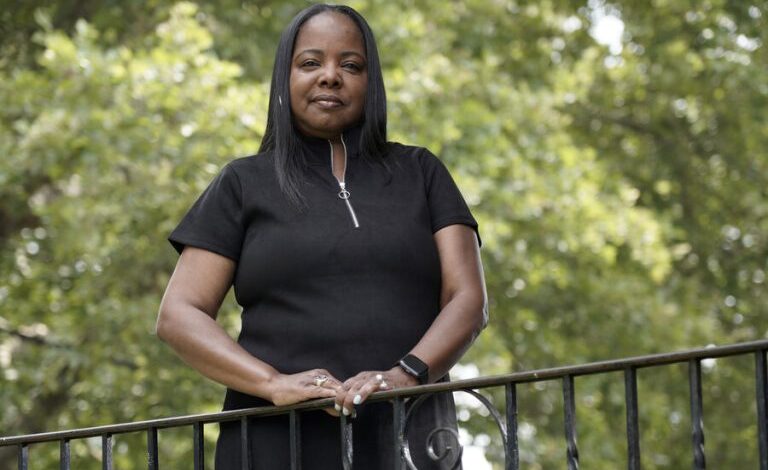Rhonda Hicks may have stored working into her 60s. She beloved educating and beloved her college students in Philadelphia’s public colleges. As a Black lady, she took satisfaction in being a task mannequin for a lot of kids of shade.
However different elements of the job deteriorated, akin to rising calls for from directors over what and the right way to train. And when she retires in a number of weeks, she’s going to be part of a disproportionately excessive variety of Black and Hispanic academics in her state who’re leaving the career.
“I take pleasure in truly educating, that half I’ve all the time loved,” mentioned Ms. Hicks who’s in her late 50s. “Typically it’s a bit of irritating. Typically the children will be troublesome. Nevertheless it’s the higher-ups: ‘Do it this fashion or don’t do it in any respect.’”
Lecturers are leaving jobs in rising numbers, state experiences present. The turnover in some instances is highest amongst academics of shade. A serious offender: stress – from pandemic-era burnout, low pay, and the intrusion of politics into lecture rooms. However the burdens will be heavier in colleges serving high-poverty communities that even have larger numbers of academics of shade.
In Philadelphia, a metropolis with one of many highest concentrations of Black residents within the U.S., the proportion of Black academics has been sliding. 20 years in the past, it was about one-third. Final fall, it fell to beneath 23%, in line with district figures.
Within the college buildings the place Ms. Hicks taught, most academics have been white. She mentioned she and different academics of shade have been anticipated to provide extra of themselves in a district the place half the scholars are Black.
“Quite a lot of occasions once you see academics which might be saving Black and brown youngsters on TV, it’s all the time the white ones,” Ms. Hicks mentioned. “There are Black academics and Hispanic academics on the market that do the identical factor in actual life, on a regular basis.”
Nationally, about 80% of American public college academics are white, despite the fact that white college students now not characterize a majority in public colleges. Having academics who replicate the race of their college students is vital, researchers say, to supply college students with function fashions who’ve perception into their tradition and life expertise.
The departures are undoing some latest success that colleges have had in bringing on extra Black and Hispanic academics. Turnover is larger amongst newer academics. And researchers have discovered that academics of shade, who are likely to have much less seniority, usually are affected disproportionately by layoffs.
In Pennsylvania, Black academics have been greater than twice as prone to depart the career as white academics after the 2021-22 college yr, in accordance to a knowledge evaluation by Ed Fuller, an schooling professor at Penn State. Hispanic and multiracial academics had the same ratio, of round twice as probably.
Black and Hispanic academics usually tend to be uncertified or educating in an underfunded district, all of which is related to somebody leaving the career at the next charge, Mr. Fuller mentioned.
“They’re in additional precarious educating positions, that means you’re ready with much less sources and worse working situations, so that you’re extra prone to give up irrespective of who you might be,” Mr. Fuller mentioned.
Sharif El-Mekki, a former Philadelphia instructor who leads the Heart for Black Educator Improvement, mentioned colleges across the nation come to him in search of assist in recruiting academics of shade. However they don’t have plans to retain them, akin to offering alternatives to assist form insurance policies and curricula.
To deal with the issue, colleges can begin by making certain college students of shade have higher experiences at school themselves and providing them alternatives to think about educating, Mr. El-Mekki mentioned. Black academics additionally usually tend to keep on at school programs which have Black leaders, he mentioned, in addition to a tradition and approaches to educating which might be anti-racist.
“We want to consider, ‘How are they experiencing my college?’” he mentioned. “If they’re having a greater expertise with us, they’re extra prone to keep.”
Attrition by academics of shade can differ drastically by state or area. Total, it has been larger in contrast with white academics for 20 years, since across the time federal insurance policies started encouraging the closure of faculties with low take a look at scores, mentioned Travis Bristol, a professor of instructor schooling and schooling coverage on the College of California-Berkeley.
In underfunded colleges with massive populations of Black and Hispanic kids, academics say they’ll count on extra obligations, fewer sources, and extra kids troubled by poverty and violence.
“I’m nonetheless within the classroom as a result of that is my model of resistance and pushing again on a system that was not designed for folk that seem like me and youngsters that seem like me,” mentioned Sofia Gonzalez, a 14-year instructor of Puerto Rican heritage in Chicago-area public colleges. “We as academics of shade have to seek out a lot internal power within us to maintain our careers in schooling.”
The previous couple of years have been a making an attempt stretch for academics in every single place. They’ve needed to navigate COVID-19, a pivot to distance studying, and the struggles with misbehavior and psychological well being that accompanied college students’ return to lecture rooms.
Then there’s the pay: Educators’ salaries have been falling behind their college-educated friends in different professions.
Instructor’s unions have warned of flagging morale, and there are indicators currently that extra educators are heading for the exits. Knowledge from at the least a handful of states – together with Pennsylvania, North Carolina, Texas, and Washington – is displaying a rise in instructor attrition.





